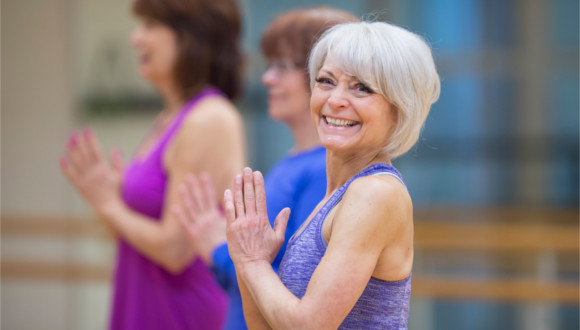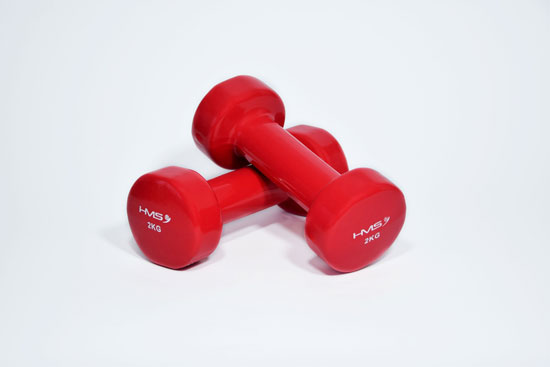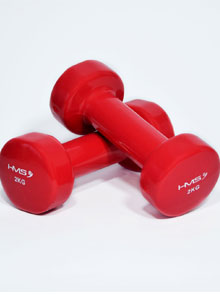It’s a well-known fact that as we get older, we lose our muscle tone and strength – that’s the bad news. The good news is that we can get back to peak muscle fitness at any age, with minimum effort.

Age-related muscle loss – also known as sarcopenia – is reversible with the right exercise and tweaks to your diet.
“We all lose muscle cells and strength as part of the process of ageing,” explains arthritis researcher Dr Tom Margham.
“However, our research has shown that many of the symptoms we associate with ageing, such as tiredness, are caused by being physically inactive. So, unless you take steps to fight it, muscles shrink and fat invades them, leading to a change in body composition that can trigger a decline in muscle function which, in turn, can lead to potentially serious and disabling problems,” he comments.
Potential causes of muscle loss include age-related decreases in some hormones, being less active, lower protein intake (and decreased ability of the body to synthesise it), as well as inflammation caused by oxidative stress (a process similar to rusting).
“But, even small lifestyle changes can help maintain and also build muscle, helping you look and feel better now for decades to come,” Dr Margham adds.
ALSO SEE: 10 Ways To Sneak In Quick Workouts
It’s never too late to reach peak muscle fitness. Regular exercise not only slows the rate of muscle loss, but can also restore muscle strength and power to your individual peak potential – no matter your age or level of fitness.
A University of London study found that exercise training three times a week, for just three months, increased knee strength by 27%. And that was shown in women aged over 75! What’s not to like?
Weight your workout
“Resistance (strength) training is what you need to build muscle, and slow muscle loss,” says Dr Margham.

Two or three 15- to 20-minute sessions a week, using free- or fixed weights or resistance bands, is enough. Start gently and build up gradually to heavier weights or stronger bands.
Yoga, Tai Chi and Pilates also enhance muscle growth and strength.
Remember cardio
According to a 2013 Canadian study, long-term aerobic exercise can boost all-over muscle strength. Cardio also helps the body use insulin, and boosts blood flow to the muscles, both essential for building healthy muscle.
Find an activity you like – dancing, running, brisk walking, biking, tennis, or swimming – and stick with it.
If you think walking might be more your speed, try our walking plan for beginners:
Get up, stand up
“The more you sit, the worse it is for both your muscles and bones,” says Dr Tahir Masud, a professor of geriatric medicine, who also conducts research into sarcopenia.
“In fact, the more you build up your muscles, the stronger your bones become. That’s because the muscles ‘load’ the bones, helping to stimulate the cells that form new bone.”
Walk up and down stairs as often as you can, and build several five- or 10-minute walks into your day.
Eat (oily) fish
Omega-3 fatty acids found in oily fish can double the benefits of strength training. “As we get older, muscles are not as good at repairing themselves after exercise, which is what stimulates them to grow,” says Dr Stuart Gray of Aberdeen University.
In a pilot study led by Dr Gray, women who did two resistance-exercise sessions, and took fish-oil supplements, had a 20 to 25% increase in muscle strength, compared to the 10 to 15% increase in those who did exercise alone.
His advice? “Make sure you eat oily fish, such as salmon, mackerel and sardines, twice each week.” Or consider taking a supplement – choose one that provides around 1,7g EPA and 0,4g DHA a day.
Try some of our delicious salmon recipes, like this salmon stir-fry:
Don’t get too skinny
As long as you’re not actually overweight, now is not the time to diet.
Slimming causes muscle loss, and you could end up with what US doctor Mark Hyman calls “skinny fat” – you’re slim, but lacking in muscle, and have excess fat, especially around the midriff – a body type that increases the risk of type 2 diabetes.
A healthy low-glycaemic diet containing lean protein (chicken, fish, and eggs), nuts, seeds, pulses, fruit, veg and wholegrains will help you to maintain a healthy weight, and provide the fuel your muscles need for physical activity.
Power up with protein
But not too much. Amino acids contained in protein foods are the vital building blocks of muscle. “But you don’t need that much,” observes Professor Michael Rennie, an expert in physiology.
Your body can’t store protein so, once it’s been broken down into amino acids, your body takes what it needs and stores the rest as fat, or flushes it out of your system in urine.
A 60kg woman needs just 48g of protein a day. A boiled egg for breakfast (13g protein), a tuna sandwich (20g protein) for lunch, and a small chicken breast (17g protein), or a portion of pulses (10g protein) for supper is enough for your dietary needs.
Soak up some sun
Research shows that low levels of vitamin D are linked to a greater risk of sarcopenia in both older women and men. Build up your vitamin-D levels by getting 15 to 20 minutes of sun exposure every day.
Worried you’re not getting enough? Ask your doctor for a blood test, and consider a supplement if you’re deficient – just 10 micrograms a day should be enough.
What is sarcopenia?
Experts still can’t agree on an exact definition, but it involves both loss of muscle mass, or bulk, and strength. It can occur from the age of 65 to 80, but generally increases from around 75.
But muscle-mass loss begins in your thirties, and if you’re not physically active, you lose between 3 and 5% of muscle mass every 10 years after age 30.
Muscle mass
Muscles shrink by around 0,5 to 1% a year from around the age of 40, mainly due to loss of the fast-twitch muscle fibres needed for high-intensity activities, such as lifting heavy objects, or quickly running for an elevator.
“During your 40s, you still have 10 to 15% more muscle than you need, but once you’re past 50, you start to lose this reserve, and muscle loss can start to affect function,” says Dr Stuart Gray, an expert in exercise physiology, who is researching sarcopenia at the University of Aberdeen.
Muscle strength
Muscle shrinkage is paralleled by a downturn in muscle strength of around 1,5% a year. As a result, the risk of trips, falls, fractures, and a host of disabilities goes up.
Pick up an avocado
Why? They’re a great source of the amino acid leucine, which studies show can help build muscle. “Leucine is not just a building block, but also signals when there are enough amino acids to stimulate the production of muscle cells,” says Professor Rennie.
Egg whites, tuna, chicken, and cottage cheese are other good sources.
Exercise training three times a week, for just three months, increases knee strength by 27%.
Video of the Month

